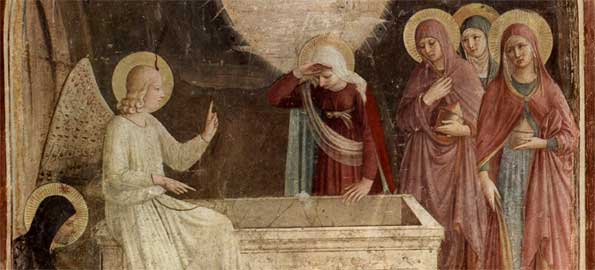
Easter, also known as Pascha (Aramaic, Greek, Latin) or Resurrection Sunday, is a Christian festival and holiday commemorating the resurrection of Jesus from the dead, described in the New Testament as having occurred on the third day after his burial following his crucifixion by the Romans at Calvary c. 30 AD.
Easter is the culmination of the Passion of Jesus, preceded by Lent (or Great Lent), a 40-day period of fasting, prayer, and penance.
Most Christians refer to the week before Easter as “Holy Week”, which contains the days of the Easter Triduum, including Maundy Thursday, commemorating the Maundy and Last Supper, and Good Friday — recognizing the crucifixion and death of Jesus. In Western Christianity, Eastertide, or the Easter Season, begins on Easter Sunday and lasts seven weeks, ending with the coming of the 50th day, Pentecost Sunday. In Eastern Christianity, the Paschal season begins on Pascha and ends with the coming of the 40th day, the Feast of the Ascension.
Easter and the related religious holidays are moveable feasts, not falling on a fixed date in the Gregorian or Julian calendars which follow only the cycle of the Sun; the Easter date is calculated based on a lunisolar calendar similar to the Hebrew calendar. The First Council of Nicaea (325) established two rules, independence of the Hebrew calendar and worldwide uniformity, which were the only rules for Easter explicitly laid down by the council. No details for the computation were specified; these were worked out in practice, a process that took centuries and generated a number of controversies. Easter is celebrated on the first Sunday after the ecclesiastical full moon that occurs on or soonest after March 21st. Even if calculated on the basis of the more accurate Gregorian calendar, the date of that full moon sometimes differs from that of the astronomical first full moon after the March equinox.
An ecclesiastical full moon is formally the 14th day of the ecclesiastical lunar month (an ecclesiastical moon) in an ecclesiastical lunar calendar. The ecclesiastical lunar calendar spans the year with lunar months of 30 and 29 days which are intended to approximate the observed phases of the Moon. Since a true synodic month has a length that can vary from about 29.27 to 29.83 days, the moment of astronomical opposition (Full Moon) tends to be roughly 14.75 days after the previous conjunction of the Sun and Moon (New Moon). The ecclesiastical full moons of the Gregorian lunar calendar tend to agree with the dates of astronomical opposition, referred to a day beginning at midnight at 0 degrees longitude, to within a day or so. However, the astronomical opposition happens at a single moment for the entire Earth: The hour and day at which the opposition is measured as having taken place will vary with longitude. In the ecclesiastical calendar, the 14th day of the lunar month, reckoned in local time, is considered the day of the full moon at each longitude.
The paschal full moon refers to the ecclesiastical full moon of the northern spring used in the determination of the date of Easter. The name “paschal” is derived from “Pascha”, a transliteration of the Aramaic word meaning Passover. The date of Easter is determined as the first Sunday after the “paschal full moon” that falls on or after March 21 (the ecclesiastical fixed date for the Spring Equinox; the actual Equinox can fall on March 19, 20 or 21). This “full moon” does not currently correspond directly to any astronomical event, but is instead the 14th day of a lunar month, determined from tables. Paschal full moon may differ from the date of the actual full moon by up to two days. The use of tables instead of actual observations of the full moon is useful and necessary since the full moon may occur on different dates depending where one is on earth.
The calculations to determine the date of the paschal full moon are somewhat complex, but can be described briefly as follows:
Nineteen civil calendar years are divided into 235 lunar months of 30 and 29 days each (the so-called “ecclesiastical moon”.)
The period of 19 years (the metonic cycle) is used because it produces a set of civil calendar dates for the ecclesiastical moons that repeats every nineteen years while still providing a reasonable approximation to the astronomical facts.
The first day of each of these lunar months is the ecclesiastical new moon. Exactly one ecclesiastical new moon in each year falls on a date between March 8 and April 5, both inclusive. This begins the paschal lunar month for that year, and thirteen days later (that is, between March 21 and April 18, both inclusive) is the paschal full moon.
Easter is the Sunday following the paschal full moon. The Easter date calculations also affect when Ash Wednesday, Maundy Thursday, Good Friday, Holy Saturday, Feast of the Ascension and Pentecost occur. Easter determines the liturgical year except the calendar of saints, feasts of the Annunciation and the nativities of St. John, the Baptist and Jesus (Christmas). Easter may occur on different dates in the Gregorian Calendar and the Julian Calendar.
In summary, Easter falls from one to seven days after the paschal full moon, so that if the paschal full moon is on Sunday, Easter is the following Sunday. Thus the earliest possible date of Easter is March 22, while the latest possible date is April 25.
Earliest Easter
Western (Gregorian)
In 1818 the Paschal Full Moon fell on Saturday, March 21 (the equinox). Therefore, the following day, March 22, was Easter. It will not fall as early again until 2285, a span of 467 years. The next earliest Easter between 1818 and 2285 (March 23) occurred in 1845, 1856, 1913 and 2008, and will occur again in 2160 — an 11, 57, 95 and 152-year gap, respectively. Easter last occurred on March 24 in 1940 and will not occur on that day until 2391, a 451-year gap.
Orthodox (Julian)
The earliest dates for Easter in the Eastern Orthodox Church between 1875 and 2099 are April 4, 1915 and April 4, 2010 (Gregorian). Both dates are equivalent to March 22 in the Julian Calendar.
Latest Easter
Western (Gregorian)
In 1943 Easter fell on Sunday, April 25. The last ecclesiastical full moon preceding the Paschal did not occur until Saturday, March 20; prior to March 21, the fixed date to which the vernal equinox is assigned for the purposes of the computus, meaning the Paschal full moon did not happen until Sunday, April 18. Consequently, Easter was the following Sunday (April 25). Easter will not fall as late again until 2038—a span of 95 years. The second latest date for Easter, April 24, occurred in 2011. The last time this occurred was in 1859 and will not happen again until 2095—spans of 152 and 84 years.
Orthodox (Julian)
The latest dates for Orthodox Easter between 1875 and 2099 are May 8, 1983, and May 8, 2078 (Gregorian). Both dates are equivalent to April 25 in the Julian Calendar. Orthodox Easter has never fallen on Gregorian May 7 yet; but will happen in 2051 unless these churches change to another calendar.

Get updates from The Cardinal ALL NEWS FEEDS on Facebook. Just ‘LIKE’ the ‘Arlington Cardinal Page (become a fan of our page). The updates cover all posts and sub-category posts from The Cardinal — Arlingtoncardinal.com. You can also limit feeds to specific categories. See all of The Cardinal Facebook fan pages at Arlingtoncardinal.com/about/facebook …
Help fund The Cardinal Arlingtoncardinal.com/sponsor
